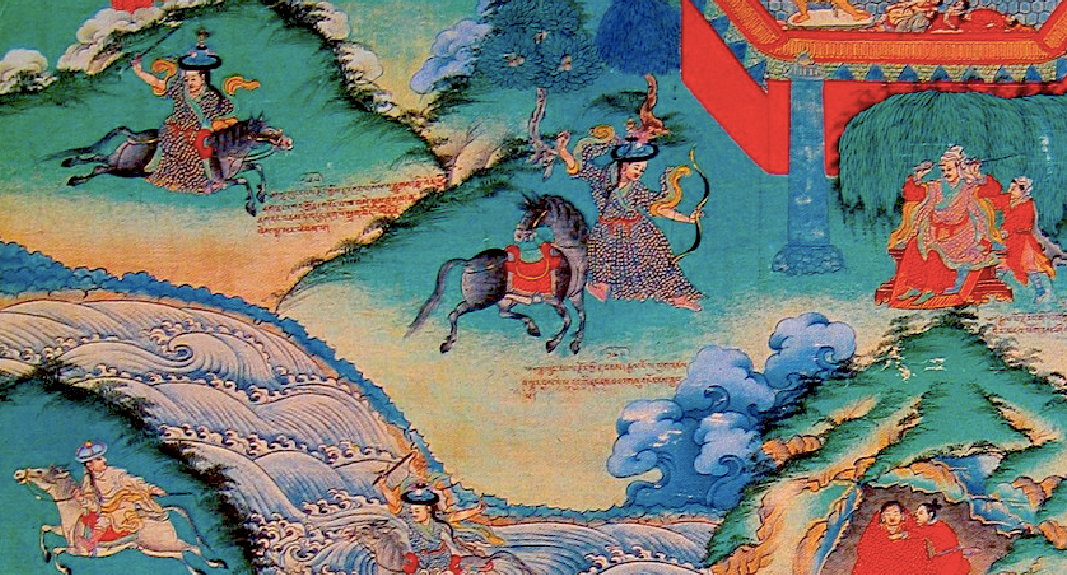
The Conspiracy and Assassination Here, An Exploration of the Tibetan Body History (9)

"Tibetan History Source Thangka Set", late 19th century
Detail: Lalong Begidogi Assassinating Udon Zan (Lhundrubma)

"Tangka Set of Historical Sources in Tibet", Late 19th Century
Detail: The assassination of Rong by the 8th Zanpu (king) of Tubo.
The martial arts competition between the monarch and his ministers turned into a plot of assassination.
The death of the emperor changed the way power was displayed in the Tubo Kingdom.
After the assassination, there was a dramatic revenge plot.
This entire plot dominated the early historical records of Tubo.
The emperor was stabbed, the killer disappeared, a shocking act of regicide occurred in the heart of the capital. The emperor turned into a demon, the killer turned into a saint, characters were given suspicious roles. The dark horse became a white horse, the black robe turned into a white robe, and the focus of history writing shifted towards the revival of religious law, with layers of apocalyptic memories added by future generations. It is worth noting that some Buddhist scholars also doubt the accuracy of this storyline.
Long before this assassination took place, the history of the Empire was filled with bloody moments of conspiracy: the sudden death of princes after a smooth transfer of the throne (the cruel inheritance system), young emperors aspiring for reform (the consequences of maternal uncle's interference), and courtiers whose lives were lost in the midst of rumors (the struggle for power). Starting from the assassination of the eighth emperor, such internal turmoil never ceased in the imperial court. The "murder narrative" of the imperial period dominated people's basic understanding of this history. Unfortunately, the noble acts of murder, fueled by lofty beliefs, began to become increasingly frequent and complex in the Buddhist context that followed.

Located in the Chamdo region of Lhoka, the original Tibetan Nyingjei Lam

Partial image: Zha Puwa poisoning
It used to be widely believed that Tsangpuwa poisoned Milarepa
(རྩག་ཕུ་བ་; Scholastic monks who doubted the monastic tradition)
The biographer attributed the reasons to "jealousy and barbarism."
(The lower left corner depicts Tsangpuwa's illicit relations with women)
But the actual reasons for his assassination may be more complex

In the first half of the 20th century, Lhasa was inhabited by people
Local: Gunman Gunkyopanda
He is the first in the line of inheritance in the book "One Hundred Formulas for Prescriptions".
He was killed by the jealous doctor, Yudongba. It is believed that he was poisoned.
After the disintegration of the empire, most of the well-known murder cases were described by people from different perspectives in biographies and legal histories, and the list of victims and perpetrators often included key figures in Tibetan history (such as Milarepa, who was both the perpetrator and victim). The motives for the murders are commonly described as a lack of character and mental deficiencies in the perpetrators, rather than specific conflicts of interest.
Selfish or arrogant, jealous or foolish, people often inject non-human factors into the personalities of most murderers, and they usually exhibit strong acts of remorse after assassinating others. For Buddhists who disregard the significance of the flesh, showing redemption after committing murder is crucial. In the Tibetan vocabulary that records acts of killing, the methods and motivations for killing form the core of the vocabulary. For example, in the vocabulary for fratricide, the core meaning of the word "དམེ་གྲིབ" is dirty, and the most heinous assassination method is poisoning, the "assassination within assassination."

The Biography Compilation of Basba, 18th Century
Excerpt from "Tibetan Buddhist Tangka Art: The Painting Biography of Basba"
In addition to the biography of Jetsun Milarepa, this work also intricately depicts the lineage of the Sakya Khon family and the various holy sites and main residences of the Sakya school.

The partial image: Pagmo Drupa passed away at Sakya Monastery (or was assassinated)

"Zaching II, Pema Banzha Dorje"
Early 20th century, private collection
Dechoe Dorji
(1898-1932/1940)
He served as the tenth regent of Zochent Monastery.
Some oral texts from the monastery suggest that he was poisoned by someone.
The perpetrator may have been a member of the monastery, possibly the steward of the Protector's Hall.
People use assassinations to tarnish the reputation of their opponents, and individuals with independent views and different opinions are ostracized from public view. Unverifiable assassination acts have become a common weapon of public opinion in the Tibetan region. Conversely, people are also hesitant to believe that individuals with supreme status can be assassinated or assassinate others, so well-documented assassination acts are deliberately ignored or glorified. When the founder of the Pandatsang family, Nyima Pandatsang (1865-1921), was shot dead in a garden during the World Peace Festival, people believed that the perpetrator was just a poor scapegoat (released due to lack of evidence). Various factions in Lhasa began attacking each other, each claiming that the other was the mastermind behind the assassination, and to this day, the identity of the assassin remains unknown.

difficult to admit, to make excuses

